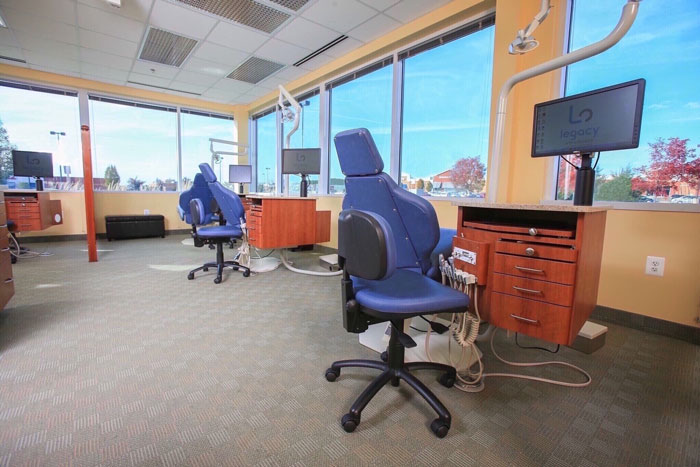The 8-Second Trick For Legacy Orthodontics
Table of ContentsFascination About Legacy OrthodonticsIndicators on Legacy Orthodontics You Should KnowLegacy Orthodontics Fundamentals ExplainedLegacy Orthodontics Can Be Fun For EveryoneLegacy Orthodontics for Beginners
In enhancement, we supply flexible therapy timetables, adaptable settlement options and a fun, delightful experience.An orthodontist is a dental expert trained to identify, protect against, and deal with teeth and jaw abnormalities. They deal with existing conditions and are trained to determine issues that may develop in the future. Orthodontists collaborate with people of all ages, from children to grownups. People commonly link a perfect smile with health.
Malocclusion, or misaligned teeth, can bring about dental problems, including tooth degeneration, periodontal disease, and challenging or excruciating eating. Not everyone is birthed with straight teeth. If you have a poor bite or large rooms between your teeth, you might desire to seek advice from a dental expert concentrating on orthodontic care.
Legacy Orthodontics Can Be Fun For Everyone
( Picture Credit History: DigitalVision/Getty Images) Orthodontists utilize fixed and removable oral devices, like dental braces, retainers, and bands, to transform the setting of teeth in your mouth. Orthodontic therapy is for oral irregularities, consisting of: Jagged teethBite problems, like an overbite or an underbiteCrowded teeth or teeth that are as well much apartJaw misalignmentThe objective of orthodontic treatment is to enhance your bite.
A healthy and balanced bite ensures you can eat, eat, and speak effectively. While you could think about orthodontists as generally for youngsters or teenagers that need dental braces, they can fix oral troubles at any kind of age. Orthodontists attend college, dental college, and orthodontic school. After graduation, they spend 2 or 3 years in an orthodontic residency program.
All orthodontists are dental experts, yet not all dental practitioners are orthodontists. Orthodontic residency programs offer intensive, focused direction for dental professionals. They concentrate on 2 locations: Exactly how to properly and safely relocate teeth Exactly how to correctly guide advancement in the teeth, jaw, and faceOnce an orthodontist has completed training, they have the option to end up being board certified.
The Basic Principles Of Legacy Orthodontics
Malocclusion leads to tooth congestion, an askew jaw, or irregular bite patterns. Malocclusion is normally treated with: Your orthodontist attaches steel, ceramic, or plastic square bonds to your teeth.
Some people need a headgear to aid move teeth published here into line with pressure from outside the mouth. A retainer is a customized gadget that maintains your teeth in area.
They're usually used on children. They can create added room in the mouth without needing to draw teeth. If you have a significant underbite or overbite, you might require orthognathic surgical procedure (also called orthodontic surgery) to extend or shorten your jaw. Orthodontists use cables, medical screws, or plates to support your jaw bone.
You might need to see an orthodontist if you have: Crowding or not sufficient space for every one of your teethOverbite, when your upper teeth come over your base teethUnderbite, when your bottom teeth are too far forwardSpacing or problems with gapsCrossbite, which is when your top teeth fit behind your base teeth when your mouth is closedOpen bite or an upright space between your front base and top teethMisplaced midline, when the center of your base and upper teeth don't align Remedying a dental malocclusion can: Make attacking, chewing, and talking easierImprove the balance of our face and your general appearanceEase pain from temporomandibular joint disordersDifferent your teeth and make them less complicated to clean up, assisting stop tooth decay or cavities It's often a dental practitioner who first notices misaligned teeth during a regular exam.
The Ultimate Guide To Legacy Orthodontics

Throughout your very first orthodontic assessment, you'll likely have: An oral examPhotos taken of your face and smileDental X-raysPanoramic (360 level) X-rays of your face and headImpressions to produce mold and mildews of your teethThese tests will certainly assist your orthodontist know how to wage your therapy. clear braces. An orthodontist is a dental expert who's had training to treat your teeth and jaw
Orthodontists may execute surgical treatment, exams,X-rays,and more to assist you attain a more comfortable, healthier smile. An orthodontist is focused on your bite, so something like a broken tooth would certainly be dealt with by a dental practitioner. Orthodontists are dentists but not all dental practitioners are orthodontists. Orthodontists are focused on your bite, or the means your teeth meshed, and the straightness of your teeth.
Ever before asked yourself just how stars constantly seem to have completely straightened teeth? Orthodontists are dental experts that concentrate on dealing with irregularities in the teeth and jaws.
Some Known Details About Legacy Orthodontics

, orthodontists have a diverse toolkit at their disposal. These reliable braces use a system of brackets adhered to the teeth and connected by wires.
These detachable trays are tailor-made to considerably change the teeth's placement. In cases of narrow jaws, palatal expanders can be used to create space for proper tooth positioning.